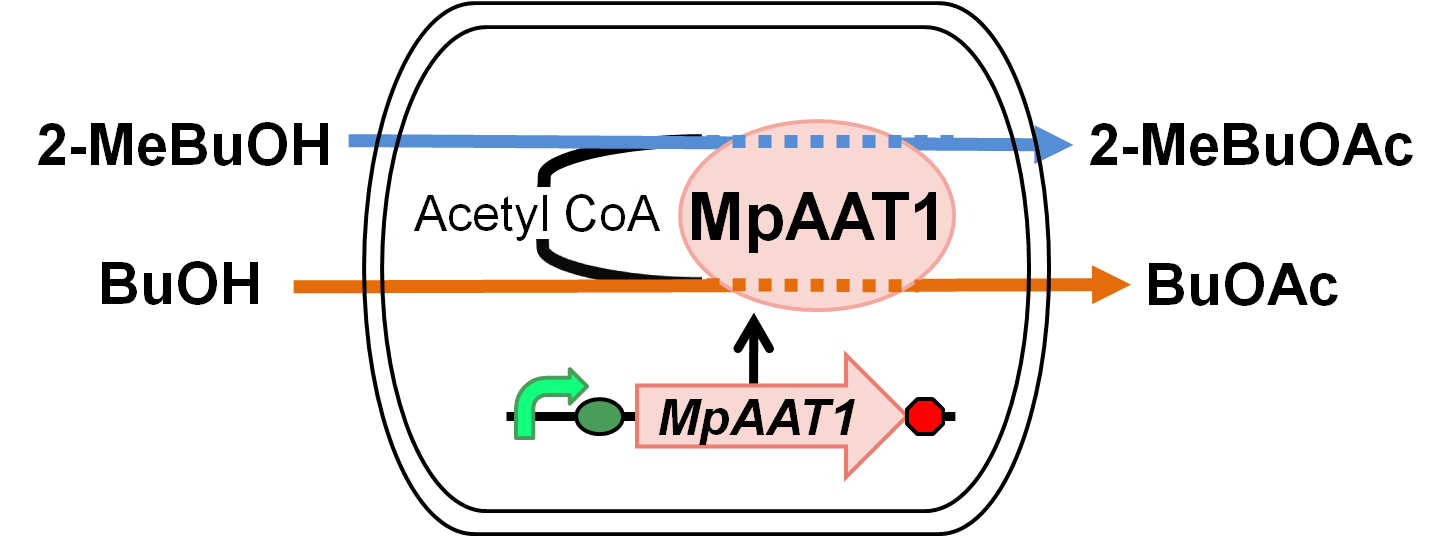Team:Tokyo Tech/Project/Apple Reporter2
From 2010.igem.org
| Line 40: | Line 40: | ||
<div id="tf_SubWrapper"> | <div id="tf_SubWrapper"> | ||
<font size="5"><b>2-2 Fragrance</b></font> | <font size="5"><b>2-2 Fragrance</b></font> | ||
| - | |||
| - | |||
| - | |||
| - | = | + | =Abstract= |
We designed apple fragrance expression device with MpAAT1. Fig. 2-2-1 shows the outline of the device. MpAAT1 converts substrate and Acetyl CoA into apple fragrance. Acetyl CoA exists originally in E.coli cell.When 2-methyl butanol or butanol is added as substrates, 2-methylbutyl acetate or butyl acetate is produced and it gives off apple fragrance. | We designed apple fragrance expression device with MpAAT1. Fig. 2-2-1 shows the outline of the device. MpAAT1 converts substrate and Acetyl CoA into apple fragrance. Acetyl CoA exists originally in E.coli cell.When 2-methyl butanol or butanol is added as substrates, 2-methylbutyl acetate or butyl acetate is produced and it gives off apple fragrance. | ||
| Line 52: | Line 49: | ||
We performed gas chromatography to confirm the production of the esters, and the results revealed that MpAAT1 successfully converted alcohol and Acetyl CoA into our target esters. | We performed gas chromatography to confirm the production of the esters, and the results revealed that MpAAT1 successfully converted alcohol and Acetyl CoA into our target esters. | ||
| + | |||
| + | =Introduction= | ||
| + | Apple fragrance is featured by combinations of volatile compounds, including alcohols, aldehydes, ketones, sesquiterpenes and esters. Esters are associated with fruity attributes of fruit fragrance. In the commercial apple cultivar, over 30 esters have been identified.[Ref]Ester biosynthesis is catalyzed by alcohol acyl transferases (AATs) that use coenzyme A(CoA) donors together with alcohol acceptors as substrates. | ||
| + | We learned it’s able to make ''E. coli'' produce apple fragrance by adding the gene MpAAT1 because Acetyl CoA exists originally in ''E.coli''. MpAAT1 produces a predicted protein containing character of other plant acyl transferases. In contrast with production of pigment, production of fragrance has hardly been worked in iGEM and few parts exist.For these reasons, we introduced a new BioBrick part to synthesize components of apple fragrance. | ||
| + | |||
=Result= | =Result= | ||
Revision as of 14:17, 27 October 2010
2-2 Fragrance
Contents |
Abstract
We designed apple fragrance expression device with MpAAT1. Fig. 2-2-1 shows the outline of the device. MpAAT1 converts substrate and Acetyl CoA into apple fragrance. Acetyl CoA exists originally in E.coli cell.When 2-methyl butanol or butanol is added as substrates, 2-methylbutyl acetate or butyl acetate is produced and it gives off apple fragrance.
We performed gas chromatography to confirm the production of the esters, and the results revealed that MpAAT1 successfully converted alcohol and Acetyl CoA into our target esters.
Introduction
Apple fragrance is featured by combinations of volatile compounds, including alcohols, aldehydes, ketones, sesquiterpenes and esters. Esters are associated with fruity attributes of fruit fragrance. In the commercial apple cultivar, over 30 esters have been identified.[Ref]Ester biosynthesis is catalyzed by alcohol acyl transferases (AATs) that use coenzyme A(CoA) donors together with alcohol acceptors as substrates. We learned it’s able to make E. coli produce apple fragrance by adding the gene MpAAT1 because Acetyl CoA exists originally in E.coli. MpAAT1 produces a predicted protein containing character of other plant acyl transferases. In contrast with production of pigment, production of fragrance has hardly been worked in iGEM and few parts exist.For these reasons, we introduced a new BioBrick part to synthesize components of apple fragrance.
Result
We introduced MpAAT1(BBa_K395602) on pSB6A1 along with pTrx6 into E.coli BL21 DE3, and cultured after addition of alcohols(2-MeBuOH or BuOH) as substrates. After 12 hours of incubation, we extracted organic soution layer from the culture and analyzed by gas chromatography (Fig. 2-2-2). Peaks of the esters producing apple fragrance(2-MeBuOAc or BuOAc) were detected.
We designed and constructed a device for apple fragrance production from intracellular metabolites (BBa_K395602). We analyzed cultures with the apple fragrance biosynthetic device for Butyl acetate and 2-methylbutyl acetate production and measured by gas chromatography.(A)Apple fragrance generator (BBa_K395602) in the presence of butanol produces measurable quantities of butyl acetate.(B)Apple fragrance generator (BBa_K395602) does not produce measurable quantities of butyl acetate in the absence of butanol.(C)For reference, we analyzed pure butyl acetate.(D)Apple fragrance generator (BBa_K395602) in the presence of 2-methyl butanol produces measurable quantities of 2-methylbutyl acetate.(E)Apple fragrance generator (BBa_K395602) in the absence of 2-methyl butanol does not produce measurable quantities of 2-methylbutyl acetate(F)For reference, we analyzed pure 2-metylbutyl acetate.(G)For negative control, we analyzed with no sample. Undecane was used as an internal standard for all samples.
Discussion
From the result of the experiment above, we can conclude that engineered E.coli successfully converted alcohols added as substrates into esters. Moreover, we synthesized MpAAT1 and esters using E.coli BL21 DE3 as a chassis, which was reported to be implausible in former report(s) (C.R. Shen, J.C. Liao. 2008). In 2008, C.R. Shen and J.C. Liao succeeded in synthesizing butanol from E.coli. If we take advantage of this engineered E.coli, we could produce apple fragrance ester without the addition of substrate.
 "
"

